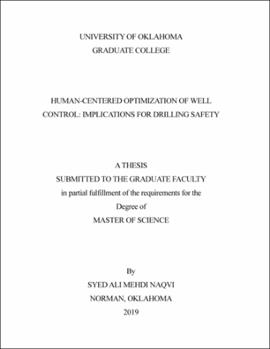| dc.contributor.advisor | Salehi, Saeed | |
| dc.contributor.author | Naqvi, Syed Ali Mehdi | |
| dc.date.accessioned | 2019-07-31T19:23:22Z | |
| dc.date.available | 2019-07-31T19:23:22Z | |
| dc.date.issued | 2019-08-01 | |
| dc.identifier.uri | https://hdl.handle.net/11244/321082 | |
| dc.description.abstract | Today 70% of incidents in offshore and marine environment are due to human factors (HF). Among all such incidents, loss of well control can have tremendous damage to human life, well, rig, underground reserves and to the environment. To reduce risk for such an incident, one needs to enhance process safety by integrating human factors in all elements design and training curriculums. The primary objective of this work is to investigate a human centered approach for reducing the risk for loss of well control events. A dual approach has been adopted which involves enhancing the computational abilities of the human and simplifying the task environment itself to promote enhanced performance. Techniques like eye tracking and content analysis has been discussed and analyzed to showcase how they can be incorporated for better training and evaluation to enhance human computational abilities. While for creating an unconvoluted task environment, dynamic well control approach through Managed Pressure Drilling (MPD) will be discussed.
DrillSim 50 simulator was used to design experiment to test and validate how eye tracking can be incorporated in the current well control training and evaluation criteria. While the Virtual Reality Drilling Simulator (VRDS) was used to conduct the content analysis experiment. As compared to rather simple binary measure of performance we get from conventional evaluation criteria. The insights on participants performance from both these techniques helped to identify areas for targeted feedback for the participants to improve on. Secondly the benchmark maps or plots from the experts generated through these techniques can be used for better evaluation of the candidates.
For creating an unconvoluted environment, dynamic well control from MPD was compared with the conventional well control method on the DrillSim 50 simulator. The comparison showed many ways in which the task environment can be simplified and made better in terms of reduced time, mental stress and physical labor. Together, this can help to create a system where task environment and abilities of the actor are complimented, resulting in optimal system performance and safety. | en_US |
| dc.language | en_US | en_US |
| dc.rights | Attribution-NonCommercial-ShareAlike 4.0 International | * |
| dc.rights.uri | https://creativecommons.org/licenses/by-nc-sa/4.0/ | * |
| dc.subject | Well Control | en_US |
| dc.subject | Human Factors | en_US |
| dc.subject | Eye Tracking | en_US |
| dc.subject | Drilling Simulations | en_US |
| dc.subject | Safety | en_US |
| dc.title | HUMAN-CENTERED OPTIMIZATION OF WELL CONTROL: IMPLICATIONS FOR DRILLING SAFETY | en_US |
| dc.contributor.committeeMember | Teodoriu, Catalin | |
| dc.contributor.committeeMember | Ahmed, Ramadan | |
| dc.date.manuscript | 2019-07-25 | |
| dc.thesis.degree | Master of Science | en_US |
| ou.group | Mewbourne College of Earth and Energy::Mewbourne School of Petroleum and Geological Engineering | en_US |
| shareok.orcid | 0000-0003-2379-4811 | en_US |

